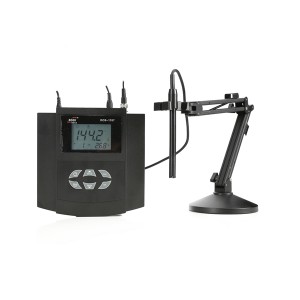Features
DOG-208F Dissolved Oxygen Electrode applicable for Polarography Principle.
With platinum (Pt) as cathode and Ag / AgCl as anode.
The electrolyte is 0.1 M potassium chloride (KCI).
The silicone rubber permeable membrane imported from U.S. serves as the permeable membrane.
It has silicone rubber and steel gauze.
It is featured by collision resistance, corrosion resistance, high.temperature resistance, shape retention and other performances.
| Measuring range: 0-100ug/L 0-20mg/L |
| Electrode material: 316L stainless steel |
| Temperature compensation resistor: 2.252K 22K Ptl00 Ptl000 etc |
| Sensor life: >3 years |
| Cable length: 5m (double shielded) |
| Detection lower Limit: 0.1ug/L(ppb)(20℃) |
| Measurement upper limit: 20mg/l(ppm) |
| Response time: ≤3min(90%,20℃) |
| Polarization time: >8h |
| Minimum flow rate: 5cm/s; 515 L/h |
| Drift: <3%/month |
| Measurement error: <±1 ppb |
| Air current: 50-80nA Note: Maximum current 20-25 uA |
| Polarization voltage: 0.7V |
| Zero Oxygen: <5ppb(60min) |
| Calibration intervals: >60 days |
| Measured water temperature:0~60℃ |
Applied to thermal power plants, power plant desalted water, boiler feed water etc places of trace oxygen content.
Dissolved oxygen is a measure of the amount of gaseous oxygen contained in water. Healthy waters that can support life must contain dissolved oxygen (DO).
Dissolved Oxygen enters water by:
direct absorption from the atmosphere.
rapid movement from winds, waves, currents or mechanical aeration.
aquatic plant life photosynthesis as a by-product of the process.
Measuring dissolved oxygen in water and treatment to maintain proper DO levels, are crucial functions in a variety of water treatment applications. While dissolved oxygen is necessary to support life and treatment processes, it can also be detrimental, causing oxidation that damages equipment and compromises product. Dissolved oxygen affects:
Quality: The DO concentration determines the quality of source water. Without enough DO, water turns foul and unhealthy affecting the quality of the environment, drinking water and other products.
Regulatory Compliance: To comply with regulations, waste water often needs to have certain concentrations of DO before it can be discharged into a stream, lake, river or waterway. Healthy waters that can support life must contain dissolved oxygen.
Process Control: DO levels are critical to control biological treatment of waste water, as well as the biofiltration phase of drinking water production. In some industrial applications (e.g. power production) any DO is detrimental for steam generation and must be removed and its concentrations must be tightly controlled.
















